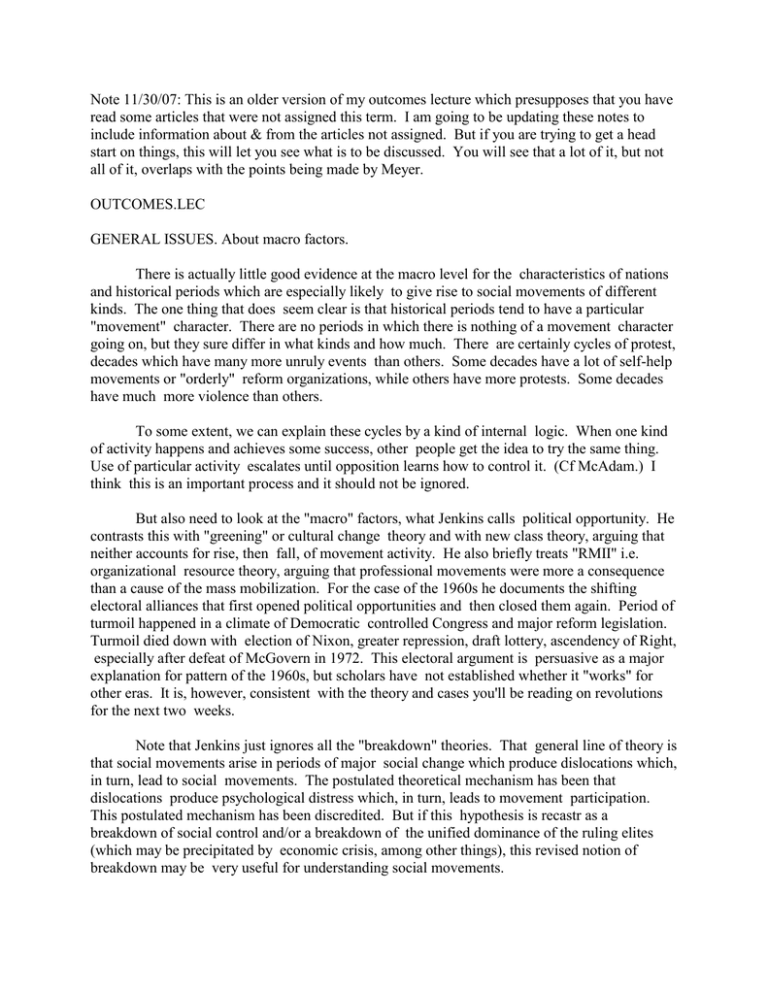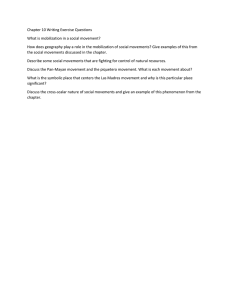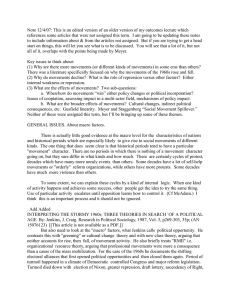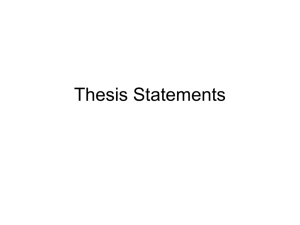Note 11/30/07: This is an older version of my outcomes... read some articles that were not assigned this term. ...
advertisement

Note 11/30/07: This is an older version of my outcomes lecture which presupposes that you have read some articles that were not assigned this term. I am going to be updating these notes to include information about & from the articles not assigned. But if you are trying to get a head start on things, this will let you see what is to be discussed. You will see that a lot of it, but not all of it, overlaps with the points being made by Meyer. OUTCOMES.LEC GENERAL ISSUES. About macro factors. There is actually little good evidence at the macro level for the characteristics of nations and historical periods which are especially likely to give rise to social movements of different kinds. The one thing that does seem clear is that historical periods tend to have a particular "movement" character. There are no periods in which there is nothing of a movement character going on, but they sure differ in what kinds and how much. There are certainly cycles of protest, decades which have many more unruly events than others. Some decades have a lot of self-help movements or "orderly" reform organizations, while others have more protests. Some decades have much more violence than others. To some extent, we can explain these cycles by a kind of internal logic. When one kind of activity happens and achieves some success, other people get the idea to try the same thing. Use of particular activity escalates until opposition learns how to control it. (Cf McAdam.) I think this is an important process and it should not be ignored. But also need to look at the "macro" factors, what Jenkins calls political opportunity. He contrasts this with "greening" or cultural change theory and with new class theory, arguing that neither accounts for rise, then fall, of movement activity. He also briefly treats "RMII" i.e. organizational resource theory, arguing that professional movements were more a consequence than a cause of the mass mobilization. For the case of the 1960s he documents the shifting electoral alliances that first opened political opportunities and then closed them again. Period of turmoil happened in a climate of Democratic controlled Congress and major reform legislation. Turmoil died down with election of Nixon, greater repression, draft lottery, ascendency of Right, especially after defeat of McGovern in 1972. This electoral argument is persuasive as a major explanation for pattern of the 1960s, but scholars have not established whether it "works" for other eras. It is, however, consistent with the theory and cases you'll be reading on revolutions for the next two weeks. Note that Jenkins just ignores all the "breakdown" theories. That general line of theory is that social movements arise in periods of major social change which produce dislocations which, in turn, lead to social movements. The postulated theoretical mechanism has been that dislocations produce psychological distress which, in turn, leads to movement participation. This postulated mechanism has been discredited. But if this hypothesis is recastr as a breakdown of social control and/or a breakdown of the unified dominance of the ruling elites (which may be precipitated by economic crisis, among other things), this revised notion of breakdown may be very useful for understanding social movements. III. OUTCOMES (Lots of notes on specific articles) The most important thing to stress is the great variety of different outcomes. Movements have diffuse and indirect consequences. POSSIBLE WAYS MOVEMENTS CAN HAVE EFFECTS. 1. Influence legislation. (raises issues of what other alliances, forces were operating, whether legislation is exactly what groups wanted, or only related.) 2. Influence public opinion. short term. long term changes -- e.g. permanent shifts in public opinion about women, overt prejudice against blacks. 3. Change participants. movement activists become permanently different. They go on to future movements. Or, they bring their changed selves into "mainstream" events. Richard Flacks argued that biggest effect of 1960s movements would be when 1960s people turned 40, started moving into power. (So far, it all seems to be yuppies. Raises the point about "generation." Activists of the period vs others.) 4. Change frames of reference, definitions of situation. Language of political discourse. 5. Lead individuals to change lives. male-female, black-white. 6. Affect political alignments. Affect structuring of economic opportunities. The most important thing to stress is the great variety of different outcomes. Movements have diffuse and indirect consequences. Gamson, Strategy of Social Protest, sampled 53 challenging groups. Had very simple notions of "success." (1) achieved one or more of group's stated goals, (2) accepted as valid spokesman for group or issue it represents. He found that larger, more centralized organizations which addressed nondisplacing goals and avoided having violence used on them were most likely to succeed by one or both of these criteria. Gusfield, Linearity and Nonlinearity. Argues that you need a much more diffuse conception of movements and movement outcomes. While not buying all of Gusfield's details, I agree with his basic approach, that it is inappropriate to examine movements simply in terms of a list of goals and whether they are met. But if you do this, it gets much more complex. Consider also notions of movement decline in Zald and Ash, Miller, etc. Here you're measuring the movement in terms of recruitment, involvement. But, oddly enough, winnig some victories is viewed as "bad" because it lowers involvement. Miller. End of SDS, emergence of weatherman. 4 sources of decline: repression, cooptation, success, failure. SDS had open structure. thus dominated by those who stuck around. challenge of PL. no clear roles for new recruits. decentralized. fragmented. Founded 1960; Port Huron statement 1962; Education Research Actio Project, community organizing, 1963-5; anti war march drawing 15,000 demonstrators 1965. Had 100,000 members by 1969, but at same time was collapsing. by 1968, being repressed by government, universities. by 1967, some of their positions had entered public debate, moderate antiwar. PL started joining in 1966, by 1968 PL factions were battling for control. women also battling for power 1968-9. Weatherman arose from position paper opposing PL in 1969, saying that international fight against US imperialism the main struggle and black liberation movement the vanguard in US. fight, split of SDS at 1969 convention. PL claimed the SDS name after being expelled by Weather (who called selves Revolutionary Youth Movement). Weatherman was very tightly organized: wanted to organize blue collar youth, but secretive, closed, no way to draw in recruits while being such a brutal way to live that people would quit. small acts of violence. fall 1969 Chicago "days of rage" attracted only 500-800 people. went underground. summary: declined partly due to repression, partly due to success drawing in new people which led to factionalism, plus changing external climate. also failure to have anything to do with new members. McAdam Decline of Civil Rights Movement (1) figure p. 301: movement events precede external funding, and then declined whie external funding continued to go up. (2) ideal movement structure is strong organizations linked in a reticulate structure; this was present for a while then declined. Through 1965, the big 4 (NAACP, SCLC, CORE, and SNCC) dominated movement actions; after then, organizations proliferated. early period was focused on desegregation; later on a wide variety of issues. targets shift to economic elites. factionalism went way up after 1965. Political opportunities: in 1930s, blacks were dependably Dem, but in 1950s, 40% of blacks voted for Eisenhower. both sides were concerned about the black vote. 1960 the height of black electoral influence. late 1960s, whites defecting from Dems. 1970 white backlash. by late 1960s, civil rights declined in salience to white liberal voters. external support went increasingly to NAACP, shutting off CORE, SNCC, and SCLC. as movement shifted north, lost the convenient foil of the white racist who could be depended upon to overreact. after 1965, the federal govt became more repressive. legal battles, informers. police got better at riot control. Robert Ross. Generational Change. (SDS) importance of primary groups in orgs, and importance of drawing new recruits into them. tells the story of the gulf between the founding members of SDS and the members that entered after 1965. Joseph Gusfield. "Social Movemetns and Social Change: linearity and fluidity. Linear: conscious action, unit of analysis is org. preoccupation with beginnings, not consequences. focuson orgs. focus on dissidence, protest, rebellion. thus focus on the state. concern with scucess or failure. emphasis on public area. Fluid: vaguer. general drifts. less directed, personal areas. instead of success or failure, asK what happened. Consequences: have to look for a very broad range of consequences, not just whether specific goals were achieved. development of a cadre, effect on subsequent movemetns. create new vocabularies. shifts in major paradigms of public discourse. Reflexivity: look at private level. the movement itself becomes an object of thought. people talk about something is changing. society change provides background for microchange. Mass Media. mass media construct public perceptions of movements. More personal movements. self-transofrmation. Examples: (1) Social Security. how it was a braod action, mostly within govt, not result of Townsend Movt. (2) alcoholism an prevention: nesting. ERA within women's, nesting. alcoholism movement became nested within prevention movement. (3) natural foods. deep symbolic meanings. natrual foods ties in with nature vs civilization movts. Anthony Oberschall. Decline of the 1960s social movements. SNCC, Black Panther Party, Mobe. SNCC: started 1961. peaked 1965. turned to black nationalism, Stokely Carmichael. hardly existed by 1968. Black Panthers. founded 1966 Huey Newton and Bobby Seale. call for armed self defense, Oakland. wore uniforms, inspired by Franz Fanon. many black power groups. shootout with police, killed one officer; Newton chared with murder. alliance 1967 with Peace and Freedom Party; Eldridge Cleaver PFP pres dandiate in 1968. throughout 1968, police and Panthers had increasingly violent confrontations resultingin casualties on both sides. member peaked in 1968 with 1500-2000 members. police surveilance. late 1968, Panthers purged about half of membesr. leadership defense absorbed money; none for rank and file bail or defense. switched to breakfast program, etc. more police confrontations through 1969, 1970. split into factions in 1971: newton-Hilliard vs Cleaver. Mobe: mobilization committees to end the war. major organizer of antiwar demos. a coalition of leaders, persons,a nd orgs. pacifists, radicals, etc. coordinated, arranged, publicized. esp. between 1967 and 1971. became factionalized. SDS: organizational chaos. volnerable to PL etc. factionalism. weatherman. Revision of Notes On Oberscahll Movement structure and mobilization: SMOs not all. complex cultural revolution. also interacted with politics. activist cadre, about 50 who got publicity. transitory teams. visible aggregations: identification moves. demonstrate support. 3 parts: activists, transitory temas, sympathizers who sent money: conscience constituencies. activists supplied ideology, symbols orgzn. leadership. transitory teams supplied labor. conscience constitu supplied money. issue of how much of the interaction field a particular SMO controls. in 1960s, orgs controlled little of it. Movemetn was a loose aggregation, not a unified whole. federal govt the opponent. Mass media as substitute for structure. media created media starts. hard to cover loose structure. major people and trouble spots get magnified out of proportion. battle field for domination of symbolic turf. bandwagon and reverse bandwagons effects of media on mobilization. SOCIAL CONTROL: govt spent a lot of time and money, but prosecuted no one. were not able to prevent violence. but tying down leaders in costly court battles (even though they eventually were acquitted) had some effect. says it is hard for repression to work in the US. Internal weakness was more important than repression in the decline of the movt. Movt won some partial successes. Conclusion is bitter and sweeping. doesn't particularly follow from forgoing, but worth reading. stress on system's ability to reform, coopt movt leaders. pass costs of reforms down to lower classes. movt leaders bear no costs. William Anderson. The Reorganization of Protest. During riot.counterrioters and negotiators tried to get riot to stop after concessions were made; turned riot into demands, political. learned they needed unified alliances to get concessions. Post-riot. (1) led to emergence of new groups. both black economic programs and nationalist groups, plus War on Poverty money funding groups more marginal to protest. (2) changed existing groups. riots left existing black leaders looking like they had no base, no power. shifted goals, programs. (3) increase in community solidarity through the riot, widespread participation. Has led to a new coordination of action: militants get into a confrontation, moderates work to negotiate, black press and officials support dissidents, mass rallies in community, crisis is resolved.




